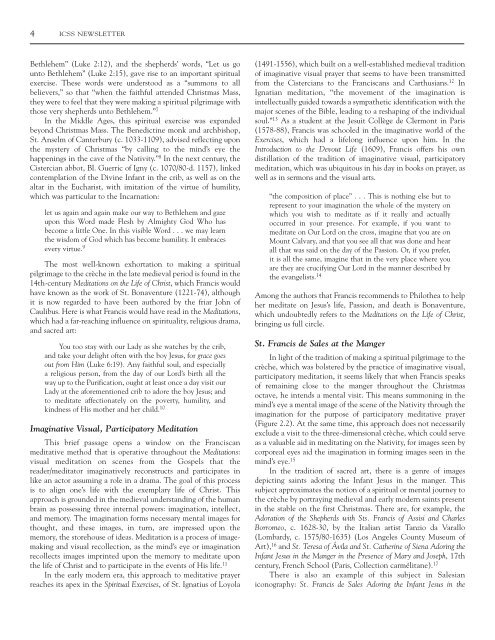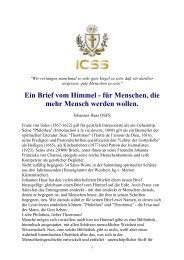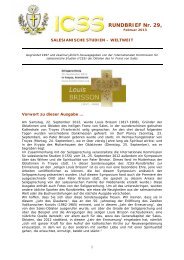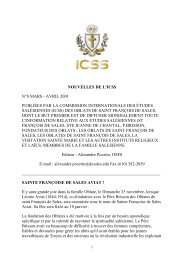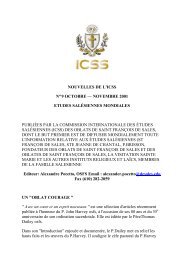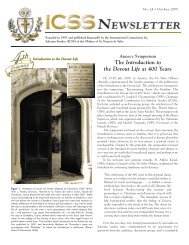St. Francis de Sales's Spirituality of the Crèche - Franz von Sales
St. Francis de Sales's Spirituality of the Crèche - Franz von Sales
St. Francis de Sales's Spirituality of the Crèche - Franz von Sales
You also want an ePaper? Increase the reach of your titles
YUMPU automatically turns print PDFs into web optimized ePapers that Google loves.
4 ICSS NEWSLETTER<br />
Bethlehem” (Luke 2:12), and <strong>the</strong> shepherds’ words, “Let us go<br />
unto Bethlehem” (Luke 2:15), gave rise to an important spiritual<br />
exercise. These words were un<strong>de</strong>rstood as a “summons to all<br />
believers,” so that “when <strong>the</strong> faithful atten<strong>de</strong>d Christmas Mass,<br />
<strong>the</strong>y were to feel that <strong>the</strong>y were making a spiritual pilgrimage with<br />
those very shepherds unto Bethlehem.” 7<br />
In <strong>the</strong> Middle Ages, this spiritual exercise was expan<strong>de</strong>d<br />
beyond Christmas Mass. The Benedictine monk and archbishop,<br />
<strong>St</strong>. Anselm <strong>of</strong> Canterbury (c. 1033-1109), advised reflecting upon<br />
<strong>the</strong> mystery <strong>of</strong> Christmas “by calling to <strong>the</strong> mind’s eye <strong>the</strong><br />
happenings in <strong>the</strong> cave <strong>of</strong> <strong>the</strong> Nativity.” 8 In <strong>the</strong> next century, <strong>the</strong><br />
Cistercian abbot, Bl. Guerric <strong>of</strong> Igny (c. 1070/80-d. 1157), linked<br />
contemplation <strong>of</strong> <strong>the</strong> Divine Infant in <strong>the</strong> crib, as well as on <strong>the</strong><br />
altar in <strong>the</strong> Eucharist, with imitation <strong>of</strong> <strong>the</strong> virtue <strong>of</strong> humility,<br />
which was particular to <strong>the</strong> Incarnation:<br />
let us again and again make our way to Bethlehem and gaze<br />
upon this Word ma<strong>de</strong> Flesh by Almighty God Who has<br />
become a little One. In this visible Word . . . we may learn<br />
<strong>the</strong> wisdom <strong>of</strong> God which has become humility. It embraces<br />
every virtue. 9<br />
The most well-known exhortation to making a spiritual<br />
pilgrimage to <strong>the</strong> crèche in <strong>the</strong> late medieval period is found in <strong>the</strong><br />
14th-century Meditations on <strong>the</strong> Life <strong>of</strong> Christ, which <strong>Francis</strong> would<br />
have known as <strong>the</strong> work <strong>of</strong> <strong>St</strong>. Bonaventure (1221-74), although<br />
it is now regar<strong>de</strong>d to have been authored by <strong>the</strong> friar John <strong>of</strong><br />
Caulibus. Here is what <strong>Francis</strong> would have read in <strong>the</strong> Meditations,<br />
which had a far-reaching influence on spirituality, religious drama,<br />
and sacred art:<br />
You too stay with our Lady as she watches by <strong>the</strong> crib,<br />
and take your <strong>de</strong>light <strong>of</strong>ten with <strong>the</strong> boy Jesus, for grace goes<br />
out from Him (Luke 6:19). Any faithful soul, and especially<br />
a religious person, from <strong>the</strong> day <strong>of</strong> our Lord’s birth all <strong>the</strong><br />
way up to <strong>the</strong> Purification, ought at least once a day visit our<br />
Lady at <strong>the</strong> aforementioned crib to adore <strong>the</strong> boy Jesus; and<br />
to meditate affectionately on <strong>the</strong> poverty, humility, and<br />
kindness <strong>of</strong> His mo<strong>the</strong>r and her child. 10<br />
Imaginative Visual, Participatory Meditation<br />
This brief passage opens a window on <strong>the</strong> <strong>Francis</strong>can<br />
meditative method that is operative throughout <strong>the</strong> Meditations:<br />
visual meditation on scenes from <strong>the</strong> Gospels that <strong>the</strong><br />
rea<strong>de</strong>r/meditator imaginatively reconstructs and participates in<br />
like an actor assuming a role in a drama. The goal <strong>of</strong> this process<br />
is to align one’s life with <strong>the</strong> exemplary life <strong>of</strong> Christ. This<br />
approach is groun<strong>de</strong>d in <strong>the</strong> medieval un<strong>de</strong>rstanding <strong>of</strong> <strong>the</strong> human<br />
brain as possessing three internal powers: imagination, intellect,<br />
and memory. The imagination forms necessary mental images for<br />
thought, and <strong>the</strong>se images, in turn, are impressed upon <strong>the</strong><br />
memory, <strong>the</strong> storehouse <strong>of</strong> i<strong>de</strong>as. Meditation is a process <strong>of</strong> imagemaking<br />
and visual recollection, as <strong>the</strong> mind’s eye or imagination<br />
recollects images imprinted upon <strong>the</strong> memory to meditate upon<br />
<strong>the</strong> life <strong>of</strong> Christ and to participate in <strong>the</strong> events <strong>of</strong> His life. 11<br />
In <strong>the</strong> early mo<strong>de</strong>rn era, this approach to meditative prayer<br />
reaches its apex in <strong>the</strong> Spiritual Exercises, <strong>of</strong> <strong>St</strong>. Ignatius <strong>of</strong> Loyola<br />
(1491-1556), which built on a well-established medieval tradition<br />
<strong>of</strong> imaginative visual prayer that seems to have been transmitted<br />
from <strong>the</strong> Cistercians to <strong>the</strong> <strong>Francis</strong>cans and Carthusians. 12 In<br />
Ignatian meditation, “<strong>the</strong> movement <strong>of</strong> <strong>the</strong> imagination is<br />
intellectually gui<strong>de</strong>d towards a sympa<strong>the</strong>tic i<strong>de</strong>ntification with <strong>the</strong><br />
major scenes <strong>of</strong> <strong>the</strong> Bible, leading to a reshaping <strong>of</strong> <strong>the</strong> individual<br />
soul.” 13 As a stu<strong>de</strong>nt at <strong>the</strong> Jesuit Collège <strong>de</strong> Clermont in Paris<br />
(1578-88), <strong>Francis</strong> was schooled in <strong>the</strong> imaginative world <strong>of</strong> <strong>the</strong><br />
Exercises, which had a lifelong influence upon him. In <strong>the</strong><br />
Introduction to <strong>the</strong> Devout Life (1609), <strong>Francis</strong> <strong>of</strong>fers his own<br />
distillation <strong>of</strong> <strong>the</strong> tradition <strong>of</strong> imaginative visual, participatory<br />
meditation, which was ubiquitous in his day in books on prayer, as<br />
well as in sermons and <strong>the</strong> visual arts.<br />
“<strong>the</strong> composition <strong>of</strong> place” . . . This is nothing else but to<br />
represent to your imagination <strong>the</strong> whole <strong>of</strong> <strong>the</strong> mystery on<br />
which you wish to meditate as if it really and actually<br />
occurred in your presence. For example, if you want to<br />
meditate on Our Lord on <strong>the</strong> cross, imagine that you are on<br />
Mount Calvary, and that you see all that was done and hear<br />
all that was said on <strong>the</strong> day <strong>of</strong> <strong>the</strong> Passion. Or, if you prefer,<br />
it is all <strong>the</strong> same, imagine that in <strong>the</strong> very place where you<br />
are <strong>the</strong>y are crucifying Our Lord in <strong>the</strong> manner <strong>de</strong>scribed by<br />
<strong>the</strong> evangelists. 14<br />
Among <strong>the</strong> authors that <strong>Francis</strong> recommends to Philo<strong>the</strong>a to help<br />
her meditate on Jesus’s life, Passion, and <strong>de</strong>ath is Bonaventure,<br />
which undoubtedly refers to <strong>the</strong> Meditations on <strong>the</strong> Life <strong>of</strong> Christ,<br />
bringing us full circle.<br />
<strong>St</strong>. <strong>Francis</strong> <strong>de</strong> <strong>Sales</strong> at <strong>the</strong> Manger<br />
In light <strong>of</strong> <strong>the</strong> tradition <strong>of</strong> making a spiritual pilgrimage to <strong>the</strong><br />
crèche, which was bolstered by <strong>the</strong> practice <strong>of</strong> imaginative visual,<br />
participatory meditation, it seems likely that when <strong>Francis</strong> speaks<br />
<strong>of</strong> remaining close to <strong>the</strong> manger throughout <strong>the</strong> Christmas<br />
octave, he intends a mental visit. This means summoning in <strong>the</strong><br />
mind’s eye a mental image <strong>of</strong> <strong>the</strong> scene <strong>of</strong> <strong>the</strong> Nativity through <strong>the</strong><br />
imagination for <strong>the</strong> purpose <strong>of</strong> participatory meditative prayer<br />
(Figure 2.2). At <strong>the</strong> same time, this approach does not necessarily<br />
exclu<strong>de</strong> a visit to <strong>the</strong> three-dimensional crèche, which could serve<br />
as a valuable aid in meditating on <strong>the</strong> Nativity, for images seen by<br />
corporeal eyes aid <strong>the</strong> imagination in forming images seen in <strong>the</strong><br />
mind’s eye. 15<br />
In <strong>the</strong> tradition <strong>of</strong> sacred art, <strong>the</strong>re is a genre <strong>of</strong> images<br />
<strong>de</strong>picting saints adoring <strong>the</strong> Infant Jesus in <strong>the</strong> manger. This<br />
subject approximates <strong>the</strong> notion <strong>of</strong> a spiritual or mental journey to<br />
<strong>the</strong> crèche by portraying medieval and early mo<strong>de</strong>rn saints present<br />
in <strong>the</strong> stable on <strong>the</strong> first Christmas. There are, for example, <strong>the</strong><br />
Adoration <strong>of</strong> <strong>the</strong> Shepherds with <strong>St</strong>s. <strong>Francis</strong> <strong>of</strong> Assisi and Charles<br />
Borromeo, c. 1628-30, by <strong>the</strong> Italian artist Tanzio da Varallo<br />
(Lombardy, c. 1575/80-1635) (Los Angeles County Museum <strong>of</strong><br />
Art), 16 and <strong>St</strong>. Teresa <strong>of</strong> Ávila and <strong>St</strong>. Ca<strong>the</strong>rine <strong>of</strong> Siena Adoring <strong>the</strong><br />
Infant Jesus in <strong>the</strong> Manger in <strong>the</strong> Presence <strong>of</strong> Mary and Joseph, 17th<br />
century, French School (Paris, Collection carmélitane). 17<br />
There is also an example <strong>of</strong> this subject in <strong>Sales</strong>ian<br />
iconography: <strong>St</strong>. <strong>Francis</strong> <strong>de</strong> <strong>Sales</strong> Adoring <strong>the</strong> Infant Jesus in <strong>the</strong>


